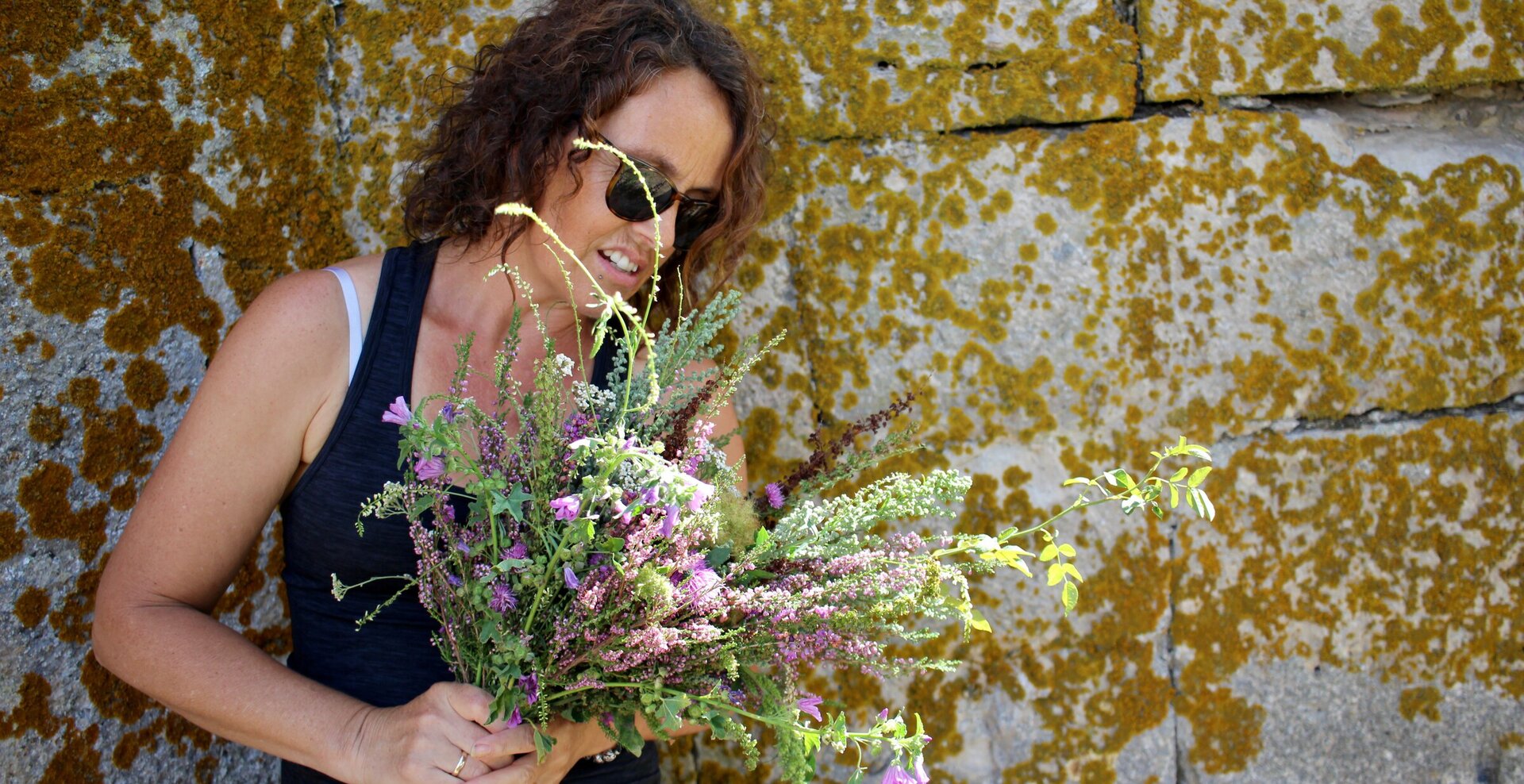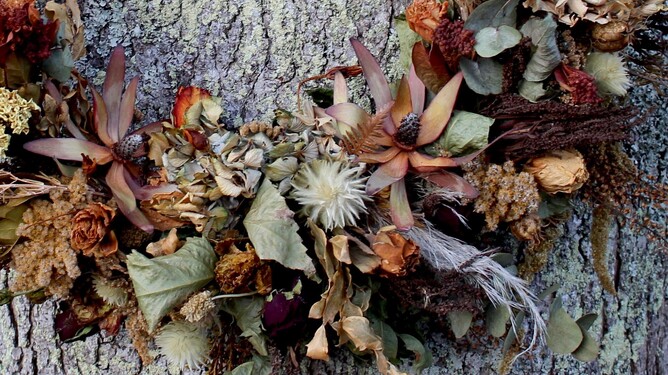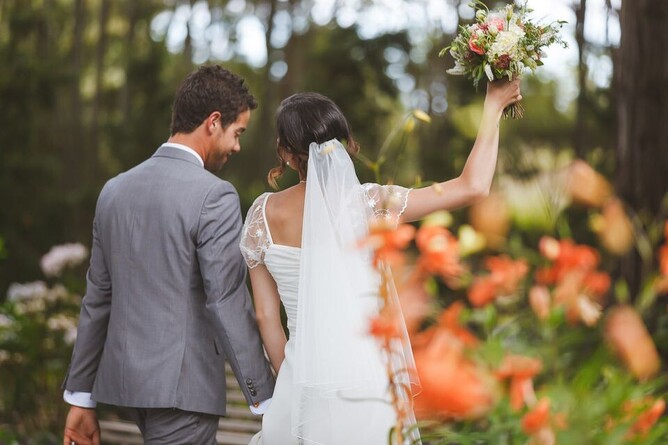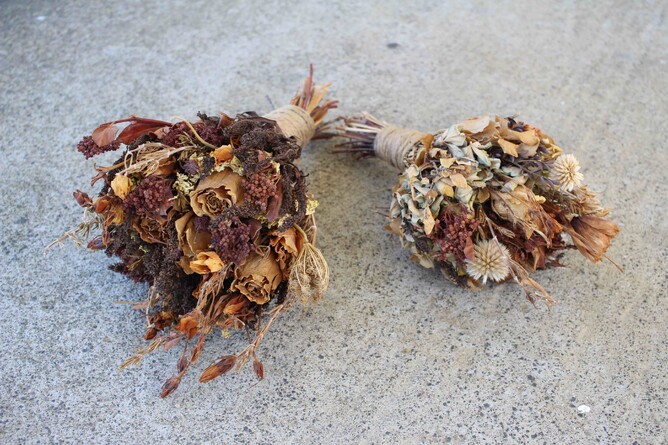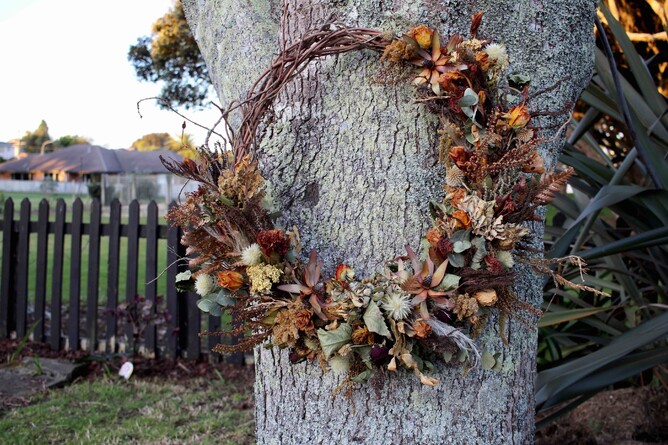I was surprised at how difficult it was, in the sentimental sense, to disassemble her bouquet. It seemed like I was walking on some kind of holy ground of the past. Sacred vows, she’d made, with these in hand.
Now years on, she was no longer that new young bride, but through “better or for worse” these flowers though faded, still represented the love and promises made. She messaged me, “I have my dried wedding and bridesmaid bouquet and … would love to have them made into a floral wreath that I could hang…”
The day I had begun working on the wreath, I searched out photos of the fresh bouquet of six years ago. The dried flowers resembled nothing of what the fresh had been, and yet there was a beauty in the way they had been preserved through being cared for over the years.
The jute binding had loosened as the stems had dried and shrunken over the years since it had been first created as a fresh bouquet for this bride to carry, like the symbolic giving of a precious gift, herself, as she had walked the isle towards her beloved.
Wedding flowers have always carried significance in history. During the Victorian age, the bride and groom exchanged flowers that had specific meaning to them. A bride would carry individual flower stems that had symbolic meaning corresponding to her character, but also represented the gift she was bringing to her lover: a white rose or lily representing her purity, a peony for good fortune, an orchid for the hope of fertility. In turn, the groom would give his bride flowers equally symbolic – a tulip representing love, a sunflower for the hope of a happy future, a red rose for the desire he had for her. And the ribbon with which the gathered flowers were then tied, symbolized the union of the two.
Underneath the jute binding of her bouquet was the typical green florist tape I recognized: the first binding technique I use also to hold the bouquet together to then be placed in a vase of water until just before the wedding, when it would be tied with its decorative binding. I wondered who the original florist was that had created this.
I also reminisced about my own wedding. It seemed inconceivable to me now that I had absolutely no input into my own wedding flowers. It was a very long time ago! It just didn’t seem a thing back then to focus on the flowers as brides do now. I remember my mum saying an aunty knew a florist - she happened to work just over the road from where I had worked as a young school leaver, but I had never been into her shop. I remembered the name. It was a little florist shop that astonishingly I discovered, is still there so many years later in the rural town I grew up in. I read the history of the business in a newspaper write up, “[her] prowess with making wreaths came to the fore as soldiers were welcomed home after the First World War ended. It originally started when the troops came back from the war. Everyone was asking [her] to make them wreaths, so she started her own business in town.” The business was afterwards, run by her daughter, who I assume was the florist who made my flowers.
I guess my mother must have given a piece of the mauve dress fabric my bridesmaids wore, but I really have no idea. The flowers just turned up on the day. There was no doubt they were beautiful: white lilies and orchids designed in the cascading fashion of the day – but I had given no thought to what the flowers or design would be. It was simply left to the expert – the florist.
It had been six years since my friend’s wedding. The flowers had well dried, and initially I worried that they would just crumble as I pulled each apart from the other. I recognized some of my favourites – Lisianthus, Sedum, Pieris, Queen Anne’s Lace, Ruscus, Hydranges, Roses. Then there were those that I could not identify: some kind of pod or berry that had been wired on a stick, amongst others. The bouquet, which had been greens, whites, pinks and plum colours had now dried to mostly creamy dried-whites and browny-reds. We had discussed that the design of the wreath would be natural to autumn colours, in keeping with her planned new home decor. I would add newly dried flowers and foliage, but would use as much of hers as possible, tucking them in amongst.
I had only intended to make a start on the wreath design, but once I had disassembled the bouquets, and got in the design groove, it had to be continued until done. I knew this was a precious privilege to be asked to do this wreath, and I felt I needed to treat it with the same kind of sentimentality it carried for her.
Several times I hung the wreath on the bare wall in my workshop area, to go over and over it, checking for mechanics, and correcting the design until it looked right to my eye…
Heck, I hope she likes it! Always for flowers of sentimental purpose, do I have those feelings of insecurity.
But her response, “I love it! It’s more than I expected. I’m sure I’m going to be looking into it and seeing new bits n pieces for ages to come. I was thinking of hanging it our bedroom, but I might have to change my mind. Thank you so much!”
